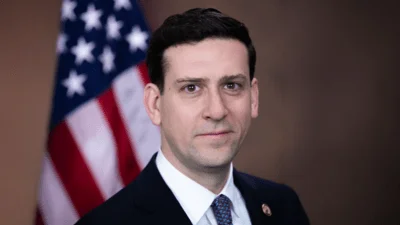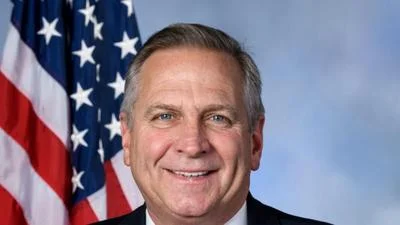Thank you, Chairman Keith and thank you to the Commission for the important work you are doing on behalf of the Department. It is an honor to be here today to provide testimony on the importance of respect for law enforcement and the rule of law in our country.
I have served as the United States Attorney for the Eastern District of Pennsylvania since April 2018, and my Office is one of the nation’s largest U.S. Attorney’s Offices. We serve a population of over five million citizens and cover a geographic area of roughly 4,700 miles across nine counties in southeastern Pennsylvania - Berks, Bucks, Chester, Delaware, Lancaster, Lehigh, Montgomery, Northampton, and Philadelphia counties. In addition to the suburban and rural areas within the District’s borders, we serve five of Pennsylvania’s eight major cities: Philadelphia, Allentown, Reading, Bethlehem, and Lancaster. In our District, the criminal behavior that we encounter runs the gamut, with a mix of issues to confront: big-city problems, small-town problems, and everything in between.
Despite these differences, every law-abiding citizen wants the same thing - to live in a community that is safe for themselves and their families. This is why this Commission’s work is so critical: the study of crime, including its causal factors, is essential to reduce its prevalence.
President Trump’s Executive Order establishing this Commission directed it to study “important current issues facing law enforcement and the criminal justice system."[1] One of the specific subjects identified for study was “refusals by the state and local prosecutors to enforce laws or prosecute categories of crime."[2]
Which brings me to the topic of this hearing and my testimony today. Though respect for law enforcement and the rule of law are broad concepts, my testimony today will primarily focus on one important and troubling recent development - that is, the undeniable fact that the rule of law and law enforcement officers are currently under attack in many parts of our nation. In many cities and counties across the country, so-called progressive prosecutors have been elected on an agenda of sending fewer people to jail, by whatever means necessary, and with little regard for the public safety consequences.[3]
Philadelphia is, in many ways, ground zero for this experiment. But there are many other cities across the United States where the top local prosecutors are pushing progressive policies.[4] And in many of these cities, prosecutors are decriminalizing certain conduct, encouraging overly lenient plea bargaining,[5] firing career prosecutors who might not share their viewpoints,[6] and shifting significant resources away from prosecution and into conviction integrity units,[7] among other significant policy changes.
My testimony today focuses on the work we have done in the Eastern District of Pennsylvania to serve as a counter-weight to some of the worst excesses of this movement. In the two-plus years I have served as U.S. Attorney, I have worked to restore a culture of respect for law enforcement and to uphold the rule of law and ensure that it is enforced in a consistent, impartial manner. I believe that the steps we have taken in the Eastern District of Pennsylvania can serve as a model for other federal districts that are facing the predictable rise in crime and chaos that results from radical “reform" policies.
The Public Safety Crisis in Philadelphia and Its Root Causes
There can be no doubt that there is a public safety crisis in Philadelphia; one need only look to the staggering rise in serious violent crime in the past two-plus years as proof. The timing coincides with a decline in the number of local cases charged in several key categories and recently, a decline in the homicide clearance rate.[8]
In 2019, Philadelphia recorded its highest number of homicides since 2007, and more people were shot in Philadelphia in 2019 than in any other year since 2010, according to Philadelphia Police statistics. The 2020 numbers are on track to be even worse. As of July 12, 2020, there have been 227 homicides, a 28% increase from the same date in 2019, and 1,578 shooting incidents, a 55% increase from the same date in 2019. On Sunday, July 6, 2020, a staggering 23 people were shot across Philadelphia - the most in a single day in years. Of these victims, six of them died, including a six-year old boy.
These statistics undoubtedly establish the problem. And in Philadelphia and other large cities where murders and shootings continue to rise at an alarming rate,[9] one of the root causes is that criminals believe that there will be no consequences for their actions.
There are two main reasons why criminals think there are no consequences.
First, the local criminal justice system does not hold them fully accountable. Criminals bank on the fact that certain progressive policies - things like requiring assistant district attorneys to decline charges and to offer lenient plea deals in a broad swath of cases - will give them some breathing room to ply their trade.
Second, criminals believe they can commit crime without facing the consequences because the community is too often told that police are the enemy, which discourages witnesses from cooperating with the police and results in crimes remaining unsolved. This has grave consequences for the community. Such mistrust also results in deadly assaults on police officers - of which unfortunately, Philadelphia has had its fair share recently.
The culture of disrespect for law enforcement was on full display in front of a national audience this past August when Maurice Hill, a convicted felon with a long rap sheet, opened fire on Philadelphia police officers as they attempted to execute a search warrant. This confrontation left six officers wounded and a neighborhood in North Philadelphia traumatized. It is a miracle that every officer survived this attack.[10]
In March of this year, the Philadelphia police were not as fortunate. On March 13, 2020, Philadelphia Police Sergeant and SWAT member James O’Connor was gunned down while trying to arrest Hassan Elliot, a known affiliate of a dangerous drug gang who was wanted by local authorities for murder and multiple other offenses.[11]
And just last month, 27 Philadelphia Police Officers were injured after a period of violence, rioting, and looting that swept across several sections of Philadelphia. What began on May 30, 2020 as peaceful protests concerning the death of George Floyd turned violent, and over the course of several days, officers sustained injuries ranging from chemical burns, head injuries, and broken bones.[12] One officer was hospitalized after suffering severe damage to his upper body - a crushed shoulder and broken ribs - when a woman drove over him when protesters turned violent during a demonstration that look place at Seventh and Chestnut Streets - steps away from Independence Hall and my Office.
As tensions continue to mount between the police and the public, police officers remain on their heels, which gives violent criminals the room to operate that they seek. Criminals literally think they can get away with murder, shootings, looting, and rioting. And in many cases, they are.
EDPA’s Response to the Rise in Violent Crime and Culture of Lawlessness
The U.S. Attorney’s Office for the Eastern District of Pennsylvania is committed to stemming the wave of violent crime that is occurring in parts of our District. This section highlights the ways in which my Office has worked to promote the rule of law and respect for law enforcement.
1. Increase Focus on Violent Crime Prosecutions
The first strategy my Office has employed is to increase our violent crime prosecutions District-wide. For example, in Fiscal Year 2019, our Violent Crime Unit charged the largest number of cases in all of the Criminal Division Units in my Office. We charged 208 violent crime cases, as compared to 136 the year before, which represents a 53% increase.
And in Philadelphia’s most dangerous neighborhoods - police districts that are designated as “Project Safe Neighborhood" hot spots - federal prosecutions continue to rise. Project Safe Neighborhood (PSN) is a collaborative effort by federal, state, and local law enforcement agencies and prosecutors to deter and punish gang and gun violence. The Department of Justice’s PSN Strategy requires each District to identify PSN “target areas" with the highest violent crime rates and adopt cases for federal prosecution in those areas. In the Eastern District of Pennsylvania, our PSN target areas are all located in police districts in Philadelphia. In Fiscal Year 2019, my Office charged 143 violent crime and illegal gun possession cases (against 195 defendants) in PSN target areas as compared to 82 cases (against 92 defendants) charged in the previous year. That amounts to a 72% increase in the number of PSN cases this Office pursued and a 112% increase in the number of defendants prosecuted.
To manage the increase in caseload, the Office has dedicated additional resources to our Violent Crime Unit. In addition to adding multiple Assistant U.S. Attorneys to the Unit, this past year, we earmarked our District’s PSN grant funds to hire two experienced prosecutors from the Criminal Law Division of the Pennsylvania Attorney General’s Office who are stationed full-time in our Violent Crime Unit, working solely on cases in the PSN target areas. We are currently in the process of hiring a third full-time attorney. These cross-designated Special Assistant United States Attorneys have served as a force multiplier in our fight against rising violent crime.
2. Seize Opportunities to Take on High Impact Cases that Serve Deterrence
My Office has also been involved in a variety of impactful criminal and civil cases and remains at the forefront of many important areas of federal law enforcement. In the face of the uncertainty created by district attorneys and city leaders who advocate pro-violent defendant policies, it is important for federal prosecutors to show the public - law abiding citizens and would-be criminals alike - that federal law enforcement will step in to fill the law enforcement vacuum. Doing so has an important deterrent effect.
For example, my Office charged a criminal case against Jouvan Patterson, who shot and nearly killed a Cambodian store owner in South Philadelphia with an AK-47 during a store robbery. We charged Patterson federally after he received an overly lenient plea deal from local authorities. Even though the victim is confined to a wheelchair, the plea deal he received on the state charge could have meant that Patterson would serve as little as 3 ½ years in prison. He faces a much longer, more appropriate sentence in our case.
In the wake of statements by Philadelphia leaders that suggested plans of leniency toward the rioters and looters who turned peaceful protests over George Floyd’s death into mayhem, my Office has offered a swift response. For example, we charged Lore-Elisabeth Blumenthal with two counts of arson after allegedly setting two Philadelphia police cars on fire in front of City Hall on May 30. We have also brought charges against defendants accused of taking advantage of the unrest by, among other things, blowing up ATM machines and burglarizing banks, and we have many active, ongoing investigations that we expect will lead to many more arrests.
In the civil context, my Office filed a civil lawsuit to prevent the opening in Philadelphia of the first-ever supervised heroin injection site in the United States. Those who support such injection sites - including some city officials - are attempting an end-run around the federal Controlled Substance Act (CSA). The case is currently on appeal before the U.S. Court of Appeals for the Third Circuit, and we expect a decision later this year.
3. Communicate Support for the Police and Share Our Deterrent Message with the Public
The progressive prosecutor reform movement has garnered significant media attention across the country. The best way to counter disrespect for law enforcement and the rule of law is to publicly challenge those who promote an anti-law enforcement culture. It is important for federal prosecutors to speak out when public safety is at risk and to support our federal, state, and law enforcement officers whenever possible.
One of the first things I did when I began my tenure as U.S. Attorney was to form a new unit called the Office of Public Affairs and External Engagement (OPAEE). OPAEE is designed to promote transparency with the community, foster relationships with law enforcement stakeholders and the public, and work with community groups on deterrence initiatives and crime prevention.
My Office has increased transparency in a number of ways. For example, I appear and speak to civic, legal, and law enforcement groups whenever possible, and take every opportunity to publicly communicate my steadfast support of the police. When significant local events occur that have a negative impact on law enforcement efforts, I share my views with the community we serve. In addition, I recently launched an anti-violence campaign across the District to deter violent crime by raising public awareness about the types of federal criminal charges that can be brought when firearms are involved. The campaign, #fedcrimegetsfedtime, features public service announcements encouraging would-be offenders to put the guns down and make the right choice for their future.
Conclusion
As senior Department of Justice officials, U.S. Attorneys have a platform and a voice to stand up for the rule of law and respect for law enforcement, which go hand-in-hand. We should use that platform responsibly and forcefully and serve as a counter-weight to radical “reform" policies that threaten public safety. As Attorney General Barr has put it, the first duty of the government is to protect the safety of our citizens. The law is the foundation of our society, and we at the Department are the caretakers of the law. By upholding the law, we make possible the common life of our nation and the freedom, safety, and equality under the law that define our country.
[1] Exec. Order No. 13896, 84 Fed. Reg. 58595 (2019), www.federalregister.gov/documents/2019/11/01/2019-24040/commission-on-law-enforcement-and-the-administration-of-justice.
[2] Id.
[3] See Emily Bazelon & Miriam Krinsky, There’s a Wave of New Prosecutors. And They Mean Justice, N.Y. Times (Dec. 11, 2018), http://www.nytimes.com/2018/12/11/opinion/how-local-prosecutors-can-reform-their-justice-systems.html.
[4] See Mark Berman, These Prosecutors Won Office Vowing to Fight the System. Now, the System is Fighting Back, Wash. Post (Nov. 9, 2019), https://www.washingtonpost.com/national/these-prosecutors-won-office-vowing-to-fight-the-system-now-the-system-is-fighting-back/2019/11/05/20d863f6-afc1-11e9-a0c9-6d2d7818f3da_story.html. The nearly two dozen prosecutors who consider themselves in this category include Chesa Boudin (District Attorney of San Francisco, California); John Creuzot (District Attorney of Dallas County, Texas); Kim Foxx (State’s Attorney of Cook County, Illinois (Chicago)); Eric Gonzalez (District Attorney of Brooklyn, New York); and Rachael Rollins (District Attorney of Suffolk County, Massachusetts (Boston)).
[5] See, e.g., The Rachel Rollins Policy Memo (Mar. 2019),. (last visited July 19, 2020).
[6] See, e.g., Gabe Dreschler, Why Did San Francisco’s New District Attorney Fire Seven Prosecutors?, KQED News, (Jan. 12, 2020), https://www.kqed.org/news/11795676/why-did-san-franciscos-new-district-attorney-fire-seven-prosecutors.
[7] Chicago District Attorney Kim Foxx revamped Cook County’s Conviction Integrity Unit, which to date, has reversed convictions of over 20 defendants. https://www.law.upenn.edu/live/profiles/1248-kimberly-m-foxx/profiles/quattroneadvisory (last visited July 19, 2020).
[8] The Philadelphia District Attorney’s Public Data Dashboard provides statistics relating to charges filed and outcomes across various types of criminal offenses. Examining the Year-to-Date Count of Cases Charged by Offense Category, as of July 17, 2020, the Dashboard reports that the District Attorney’s Office charged 30% fewer cases overall as compared to the same time period in 2019. It also reports 20% fewer violent crime cases charged, 48% fewer drug cases charged, and 31% fewer retail theft cases as compared to the same time period in 2019. https://data.philadao.com/Charge_Report.html (last visited July 19, 2020). And in reporting case outcomes year-to-date (Jan. 1, 2020 to July 17, 2020) as compared to the same time in 2019, the Dashboard reports a decrease in outcomes (defined as “the various ways a criminal case can end") in several key categories of cases charged. For example, in the category of violent offenses, case outcomes have decreased 53 percent. When broken down further, case outcomes in the category of robberies with a gun are down 65 percent; and homicide outcomes are down 62 percent. https://data.philadao.com/Case_Outcomes_Report.html (last visited July 19, 2020).
[9] Safia Samee Ali, Gun Violence Is Surging in Cities, and Hitting Communities of Color Hardest, NBC News (July 9, 2020) (discussing rise in shootings and homicides in Philadelphia, Chicago, and other major cities), https://www.nbcnews.com/news/us-news/gun-violence-surging-cities-hitting-communities-color-hardest-n1233269.
[10] Statement by United States Attorney William M. McSwain on the Shooting of Six Philadelphia Police Officers (Aug. 15, 2019), https://www.justice.gov/usao-edpa/pr/statement-united-states-attorney-william-m-mcswain-shooting-six-philadelphia-police.
[11] Statement of William M. McSwain Regarding the Murder of Philadelphia Police Corporal James O’Connor (Mar. 16, 2020), https://www.justice.gov/usao-edpa/pr/statement-us-attorney-william-m-mcswain-regarding-murder-philadelphia-police-corporal.
[12] See Fox29 News, Commissioner: 768 Arrests, 27 Officers Injured in Continued Violence in Philadelphia (June 7, 2020), https://www.fox29.com/news/commissioner-768-arrests-27-officers-injured-in-continued-violence-around-philadelphia.
Source: U.S. Department of Justice, Office of the United States Attorneys







